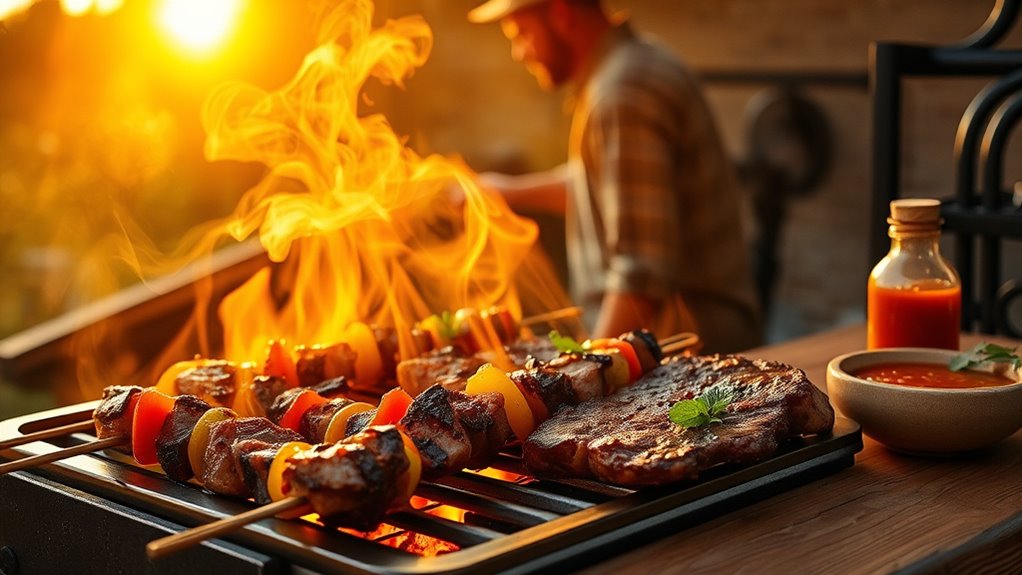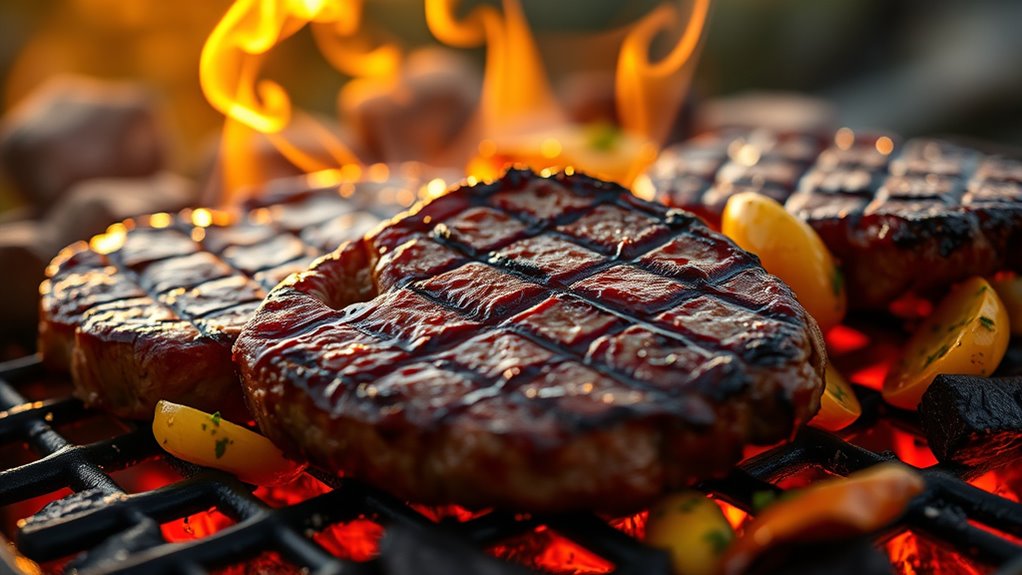Grilling brings out incredible flame-cooked flavors that elevate your meals. Start by marinating your proteins for at least 30 minutes to enhance tenderness and flavor. Preheat your grill, setting up direct and indirect heat zones for perfect cooking. Keep the lid closed to maintain temperature and infuse that smoky goodness. Don’t forget flavorful accompaniments like grilled vegetable skewers or spicy shrimp. Discover how these techniques and recipes can transform your outdoor cooking experience.
Key Takeaways
- Marinate meats for at least 30 minutes to enhance flavor and tenderness before grilling.
- Preheat the grill to create a hot surface for effective searing and prevent sticking.
- Utilize direct high heat for searing and indirect lower heat for gentle cooking.
- Keep the grill lid closed to maintain temperature and infuse smoky flavors into the food.
- Incorporate recipes like spicy grilled shrimp and vegetable skewers for flavorful grilled meals.

Have you ever wondered how to elevate your grilling game? You’re not alone. Many grilling enthusiasts seek ways to enhance their flavors and impress their friends at the next backyard barbecue. Mastering some key techniques can transform your grilling experience from ordinary to extraordinary. Let’s explore some effective methods and recipes that’ll have everyone raving about your flame-cooked masterpieces.
Elevate your grilling game with key techniques and delicious recipes that will impress at your next barbecue.
First, consider the significance of marinating your meats. A simple marinade can make a world of difference. Combine olive oil, acid (like vinegar or citrus juice), and your favorite herbs and spices. Let your proteins soak in this flavorful mixture for at least 30 minutes, or even overnight if you have the time. This process not only infuses the meat with flavor but also helps tenderize it. When you’re ready to grill, remove the meat from the marinade and pat it dry. This step guarantees a nice sear on the grill.
Next, let’s talk about the grill itself. Preheating is vital. A hot grill ensures a good sear and helps prevent sticking. Aim for two temperature zones: one for direct, high heat and another for indirect, lower heat. This setup allows you to sear your food first and then move it to the cooler side to finish cooking without burning. Don’t forget to keep the lid closed as much as possible; it helps maintain a consistent temperature and infuses the food with that smoky flavor.
Now, let’s explore some delicious recipes. For a quick and easy option, try grilled vegetable skewers. Simply chop up your favorite veggies—bell peppers, zucchini, and cherry tomatoes work great. Toss them in olive oil, salt, and pepper, then thread them onto skewers. Grill them over medium heat until they’re charred and tender. You can pair these with grilled chicken or fish for a complete meal.
If you’re feeling adventurous, whip up a spicy grilled shrimp dish. Marinate shrimp in a mix of lime juice, garlic, and chili flakes for about 20 minutes. Skewer them and grill on high heat for just a few minutes on each side until they turn pink and slightly charred. Serve them with a fresh mango salsa for a burst of flavor.
Frequently Asked Questions
What Are the Best Types of Wood for Grilling?
The best types of wood for grilling include hickory, mesquite, apple, and cherry. Hickory gives a strong, smoky flavor, while mesquite provides a bold taste that’s perfect for red meats. Apple and cherry woods add a mild sweetness, enhancing the flavor of poultry and pork. You can mix different woods to create unique flavors, but be careful not to overpower your food. Experimenting with these woods will elevate your grilling experience!
How Do I Clean My Grill Properly?
To clean your grill properly, start by disconnecting the gas and removing the grates. Use a grill brush to scrub the grates and remove any leftover food particles. For the interior, scrape off residue using a putty knife. Wipe down surfaces with a damp cloth and a mild cleaner. Don’t forget to clean the drip pan! Reassemble everything once it’s dry, and you’re ready for your next grilling adventure!
What Safety Precautions Should I Take While Grilling?
Before you ignite the flames, think of your grill as a campfire—you need to respect its power. Always keep a fire extinguisher nearby and check for gas leaks if you’re using propane. Wear heat-resistant gloves, and never leave the grill unattended. Keep children and pets at a safe distance, and use long-handled tools to avoid burns. Remember, safety’s the shield that protects your grilling experience from fiery mishaps!
Can I Grill Indoors Safely?
You can grill indoors, but it requires caution. Use an electric grill or a stovetop grill pan to avoid dangerous fumes. Make sure your kitchen is well-ventilated by opening windows or using an exhaust fan. Keep a fire extinguisher nearby, just in case. Always monitor the cooking process and never leave the grill unattended. If you smell gas or see smoke, turn off the grill and evacuate the area immediately.
How Do I Store Leftover Grilled Food?
Storing leftover grilled food is like wrapping a precious gift; you want to keep it safe. First, let your food cool down to room temperature. Then, place it in airtight containers or wrap it tightly in aluminum foil or plastic wrap. Don’t forget to label them with the date! Store in the fridge for up to four days, or freeze for longer. When you’re ready to enjoy, just reheat and savor those delicious flavors!
Conclusion
As you fire up the grill, remember that every sizzle brings a story, whether it’s the smoky embrace of charred veggies or the tender kiss of a perfectly cooked steak. Embrace the contrast of flavors and textures, from the crispy crust to the juicy interior. With each technique and recipe, you’re not just cooking; you’re creating memories. So, turn up the heat and let your grill be the canvas for your culinary masterpiece, where every bite celebrates the art of flame-cooked flavors.









